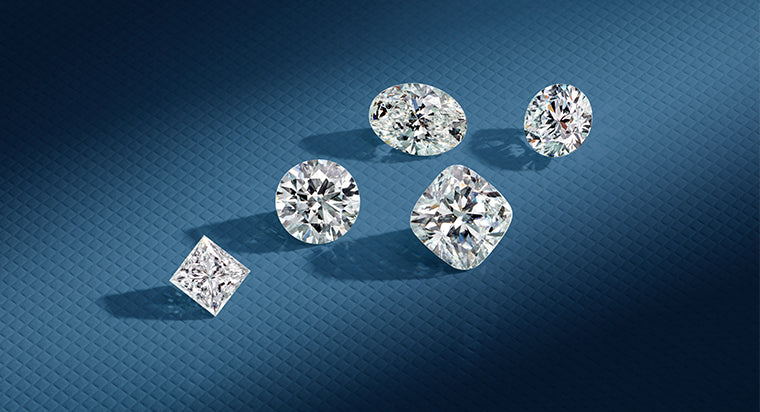When purchasing a diamond, one of the most important factors to consider is the diamond cut. Diamond cuts not only influence the aesthetic appeal of the gemstone but also impact its brilliance, sparkle, and overall value. In this article, we will explore the significance of diamond cuts, how they are graded, and why choosing the right cut is essential for every diamond purchase.
Table of Contents
ToggleWhat is a Diamond Cut?
The term “diamond cut” refers to how a diamond is shaped and faceted after being mined from the earth. It is not to be confused with the shape of the diamond (such as round, square, or oval). Rather, it speaks to the proportions, symmetry, and quality of the facets that are carved into the stone. These elements are crucial because they directly affect how light interacts with the diamond, which determines its brilliance and sparkle. A well-cut diamond reflects light in a way that makes it appear dazzling, while a poorly cut diamond can appear dull or lifeless.
The Importance of Diamond Cuts
Diamond cuts are significant for a number of reasons. First and foremost, they play a central role in the diamond’s ability to reflect light. When a diamond is cut with precision, it allows light to enter through the top, reflect off the inner facets, and exit through the crown, resulting in the radiant sparkle that man made diamonds are known for. If the cut is too deep or too shallow, the light will escape from the sides, reducing the diamond’s brilliance. Therefore, understanding diamond cuts is essential for selecting a stone that offers maximum visual appeal.
Different Types of Diamond Cuts
There are several popular types of diamond cuts, each with its own unique characteristics. The most commonly seen is the round brilliant cut, known for its 58 facets that are designed to maximize light reflection. Other popular diamond cuts include princess, emerald, and cushion cuts. Each cut has its own appeal, and the choice largely depends on personal preference and the intended use of the diamond, such as in engagement rings, necklaces, or earrings.
The princess cut is known for its sharp, square shape, while the emerald cut features long, narrow facets that create a stunning optical effect. Cushion cuts offer a vintage feel, combining rounded corners with square or rectangular shapes. Understanding the specific properties of each of these cuts can help a buyer make an informed decision when selecting their diamond.
How Diamond Cuts Are Graded
When it comes to diamond cuts, there is a grading system that evaluates the quality of a diamond’s cut. The Gemological Institute of America (GIA) is one of the leading authorities in grading diamonds. They assess cut quality based on several factors, including the diamond’s proportions, symmetry, and the overall craftsmanship. A diamond can receive one of the following grades: Excellent, Very Good, Good, Fair, or Poor.
An “Excellent” grade indicates that the diamond has been cut to near-perfect standards, ensuring maximum light reflection and brilliance. A “Very Good” grade is also a high-quality diamond, though it may have slightly less sparkle than an Excellent cut. “Good” diamonds may show some minor differences in symmetry, while “Fair” or “Poor” diamonds are generally not considered ideal for their ability to reflect light efficiently.
How Diamond Cuts Affect Value
The quality of a diamond cut can have a significant impact on its price. Diamonds with an excellent or very good cut tend to be more expensive than those with a fair or poor cut. This is because diamonds with superior cuts are rarer and more valuable due to the craftsmanship and precision required to achieve the desired proportions. However, the cut is only one factor affecting a diamond’s value. Other aspects, such as carat weight, color, and clarity, also contribute to the overall price of the stone.
It’s essential for buyers to keep in mind that the diamond cut has the most substantial effect on the diamond’s visual appeal. A high-quality cut can make a smaller diamond appear larger and more brilliant, whereas a poorly cut diamond, even with high carat weight and clarity, may fail to impress.
The Impact of Diamond Cuts on Jewelry
The diamond cut also influences how a diamond will appear when set in a piece of jewelry. For example, round brilliant diamonds are often chosen for engagement rings because of their exceptional brilliance and timeless design. On the other hand, diamonds with unique cuts, like the emerald or cushion, are popular for those looking for a more distinctive style. The cut can also affect the diamond’s setting, as certain cuts work better in specific settings, such as prong or bezel settings, which can further enhance the stone’s overall beauty.
Selecting the right diamond cut for jewelry is all about personal preference and how the diamond’s brilliance can complement the design of the piece. Some buyers may prefer a diamond cut with more intricate facets, while others might go for a simpler cut that emphasizes the natural clarity of the stone.
Conclusion
In summary, diamond cuts play an essential role in determining the overall quality and beauty of a diamond. Whether you’re purchasing a diamond for an engagement ring, a necklace, or another piece of jewelry, understanding the importance of diamond cuts will help guide your decision. Remember that a well-cut diamond reflects light more effectively, increasing its brilliance and value. Be sure to consider the different types of cuts and their grading before making a final selection, and don’t hesitate to seek expert advice to find the perfect diamond cut for your needs.

